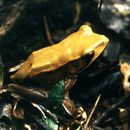Distribution and Habitat
provided by AmphibiaWeb articles
Endemic to India. Distributed widely in the Western Ghats, at elevations from 500-2,000 m asl. It is found in various type of tropical forest, including evergreen moist forest, semi-evergreen moist forest, and dry deciduous forest. This species inhabits leaf litter on the forest floor (Stuart et al. 2008).
Jerdon, T. C. (1853). ''Catalogue of the reptiles inhabiting the peninsula of India.'' Journal of the Asiatic Society of Bengal, 22, 522-534.
Life History, Abundance, Activity, and Special Behaviors
provided by AmphibiaWeb articles
Breeds in ponds and large lakes, both natural and artificial (Stuart et al. 2008).
Life History, Abundance, Activity, and Special Behaviors
provided by AmphibiaWeb articles
This is an adaptable species which can tolerate not only different forest type but also some habitat degradation. Although it can be locally abundant, population numbers are thought to be decreasing due mainly to habitat loss. Its forest habitats are being converted for agricultural use, including tea, coffee, and eucalyptus plantations, and cut down for timber and wood use. In addition, this species is subject to roadkills during breeding season, when frogs migrate to breeding habitats. It does occur within many protected areas, and it is also under national protection (Stuart et al. 2008).
Relation to Humans
provided by AmphibiaWeb articles
Tadpoles are collected for human consumption (Stuart et al. 2008).
Bicolored frog
provided by wikipedia EN
The bicolored frog or Malabar frog (Clinotarsus curtipes) is a species of frog endemic to the Western Ghats of India.[2] The tadpoles of the species are black and form dense and compact schools in slow moving streams in forested areas.
Description
The bicolored frog's vomerine teeth scarcely developed, sometimes indistinct. The teeth are in two slightly oblique series on a level with the hind edge of the choanae. Its head large; snout short, rounded, with well-marked canthus rostralis and concave loreal region ; nostril nearer to the end of the snout than to the eye; interorbital space broader than the upper eyelid; tympanum distinct, nearly as large as the eye. Fingers moderate, first extending beyond second; toes short, nearly entirely webbed; tips of fingers and toes swollen or dilated into very small disks; subarticular tubercles much developed; inner metatarsal tubercle small, oval, blunt; a rather large, flat tubercle at the base of the fourth toe; no tarsal fold. The tibio-tarsal articulation reaches the eye. Skin finely granular above; a moderately prominent, rather narrow glandular lateral fold; another told behind the tympanum down to the shoulder. Clinotarsus curtipes is greyish or brown above, with or without blackish dots; lateral fold lighter, edged with black; a blackish oblique spot or band below the eye; upper lip with a blackish margin; limbs dark purplish brown, without cross bands; light brown beneath, the throat sometimes dark brown. Male with an internal subgular vocal sac.[3][4]
The spot patterns on the backs are often distinctive enough to use for population estimation using capture and recapture techniques. Use of this technique in the Bisale Reserve Forest in Kodagu during January 1999 – July 2001 gave a population density estimate of 0.08–0.1 frogs per square metre.[5]
Adult frogs may occasionally feign death to escape predators.[6]
The tadpoles are large (more than 9 cm (3.5 in) in total length) and form shoals in slow moving streams.[7] They are collected for local consumption.[1]
Underside of a breeding male
Upperside of a breeding male
Shoals of tadpoles in a stream
References
-
^ a b S.D. Biju, Sushil Dutta, Robert Inger (2004). "Clinotarsus curtipes". IUCN Red List of Threatened Species. 2004: e.T58583A11789937. doi:10.2305/IUCN.UK.2004.RLTS.T58583A11789937.en. Retrieved 19 November 2021.
{{cite journal}}: CS1 maint: multiple names: authors list (link) -
^ Frost, Darrel R. (2014). "Clinotarsus curtipes (Jerdon, 1853)". Amphibian Species of the World: an Online Reference. Version 6.0. American Museum of Natural History. Retrieved 4 May 2014.
-
^ Boulenger, G. A. (1890) The Fauna of British India, Including Ceylon and Burma: Reptilia and Batrachia.
-
^ Desai R.N. & Pancharatna K. (2003). "Rana curtipes coloration". Herpetological Review. 34 (1): 53–54.
-
^ Krishna, S. N.; Krishna S. B. & Vijaylaxmi, K. K. (2005). "Dorsal spot pattern as unique markers to estimate the population size of Rana curtipes". Journal of the Bombay Natural History Society. 102 (1): 16–18. ISSN 0006-6982.
-
^ Gramapurohit, N. P.; Shanbhag, B. A. & Saidapur, S. K. (2001). "Rana curtipes (bicolored frog). Death feigning". Herpetological Review. 32 (2): 103.
-
^ Hiragond, Ningappa C.; Shanbhag, Bhagyashri A. & Saidapur, Srinivas K. (2001). "Description of the tadpole of a stream breeding frog, Rana curtipes". Journal of Herpetology. 35 (1): 166–168. doi:10.2307/1566044. JSTOR 1566044.

- license
- cc-by-sa-3.0
- copyright
- Wikipedia authors and editors
Bicolored frog: Brief Summary
provided by wikipedia EN
The bicolored frog or Malabar frog (Clinotarsus curtipes) is a species of frog endemic to the Western Ghats of India. The tadpoles of the species are black and form dense and compact schools in slow moving streams in forested areas.
- license
- cc-by-sa-3.0
- copyright
- Wikipedia authors and editors

